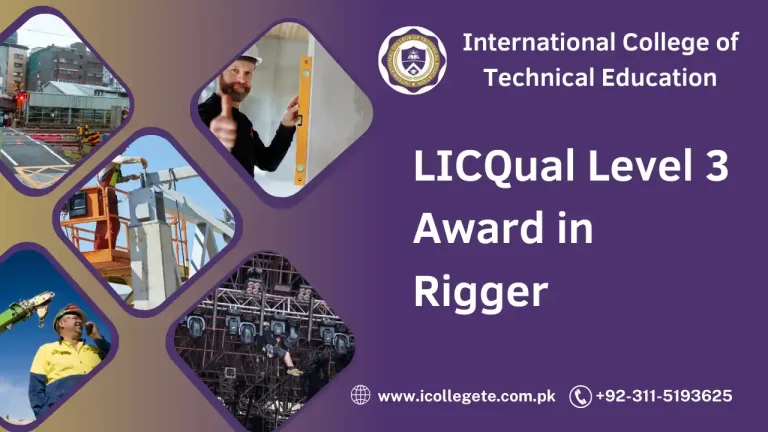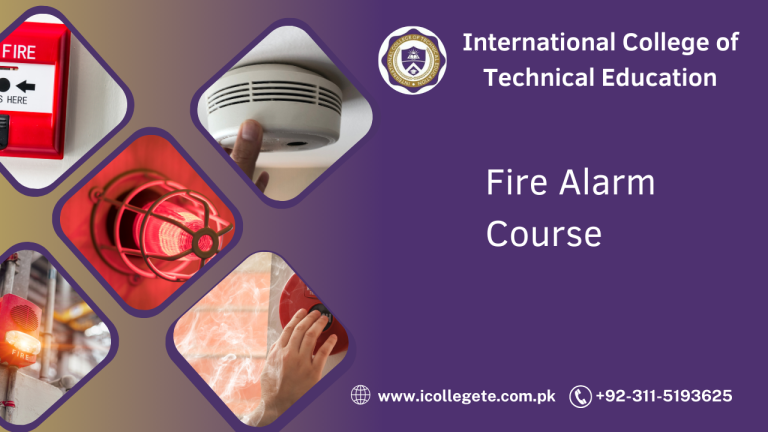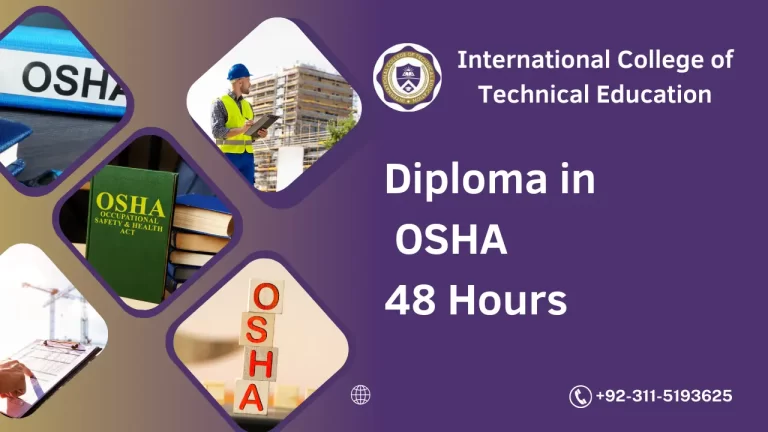In construction, industrial, and engineering sectors, rigging plays a crucial role in the safe and efficient movement of heavy equipment and materials. The Rigger Level 1 Course in Chakwal is designed to provide foundational knowledge and practical skills for those who wish to work in the rigging field.
The Rigger Level 1 Course in Chakwal offers an entry-level qualification aimed at providing essential rigging skills. It covers the safe and correct procedures for handling, securing, and moving heavy loads on construction sites or in industrial settings. The course is designed for individuals looking to work as riggers, assistants, or in related fields, and provides a strong foundation in rigging safety, equipment handling, and proper lifting techniques.
Course Overview
The Rigger Level 1 Course in Chakwal is an introductory program that teaches the fundamental principles and practices of rigging, with a focus on safety, equipment use, and the rigging process. This course prepares students to work as competent riggers in various industries, learning the necessary skills to handle tasks such as securing loads, attaching lifting gear, and following health and safety guidelines.
The course consists of theoretical lessons and practical sessions, ensuring that learners not only understand the rigging process but are also capable of applying their knowledge in real-world settings. Upon successful completion of the course, learners will be equipped to safely assist in lifting operations and provide support to more experienced riggers and crane operators.
Study Units
The Rigger Level 1 Course in Chakwal includes various study units designed to provide a comprehensive understanding of rigging basics. These units include:
- Introduction to Rigging
- The role of a rigger in various industries.
- Types of rigging equipment and tools used in lifting operations (slings, hooks, shackles, etc.).
- Basic principles of rigging, including the concept of mechanical advantage, load balancing, and weight distribution.
- Rigging Equipment and Tools
- Identification, selection, and safe use of rigging equipment.
- Maintenance and inspection of rigging tools, including slings, shackles, hoists, and winches.
- Understanding the load capacities and safe working limits of different rigging equipment.
- Safety in Rigging Operations
- Importance of safety protocols in rigging and lifting operations.
- Personal protective equipment (PPE) for riggers and other workers.
- Identifying hazards and potential risks in the rigging process.
- Correct lifting and rigging practices to avoid accidents.
- Basic Lifting Techniques
- How to attach rigging equipment to loads, ensuring safety and stability.
- Different types of hitches and knots for securing loads.
- Rigging for different load types, such as round, square, and irregularly shaped objects.
- Understanding load charts and ensuring loads are within safe weight limits.
- Lifting Plans and Communication
- The importance of pre-lift planning and coordination.
- Clear communication protocols between the rigger, crane operator, and other team members during lifting operations.
- How to perform visual checks and inspections before lifting a load.
- Basic Slinging Techniques
- The use of slings in rigging, including wire rope slings, chain slings, and synthetic slings.
- How to safely sling loads and ensure secure attachments for lifting.
- Proper use of lifting devices and ensuring the safety of both the load and personnel.
- Rigging for Different Environments
- Rigging in confined spaces, on uneven surfaces, and in challenging environments.
- Understanding the implications of weather and environmental factors on rigging safety.
- Special considerations for lifting in industrial, construction, and offshore settings.
- Legal and Regulatory Considerations
- Understanding the legal requirements and industry regulations related to rigging and lifting operations.
- Importance of certification and compliance with local and international safety standards.
- Maintaining records of inspections, lift plans, and equipment usage.
Learning Outcomes
Upon completion of the Rigger Level 1 Course in Chakwal, learners will be able to:
- Safely use and maintain basic rigging equipment, including slings, shackles, and hooks.
- Apply correct lifting techniques and slinging methods for a variety of loads.
- Understand and follow rigging safety protocols, minimizing risks during lifting operations.
- Inspect rigging tools and equipment to ensure they are in good working condition and within safe working limits.
- Communicate effectively with crane operators and other workers during lifting operations.
- Assist in planning lifting operations, considering factors such as load size, weight, and safety requirements.
- Understand the legal and regulatory requirements for rigging operations in different industries.
Course Benefits
The Rigger Level 1 Course in Chakwal provides numerous benefits for individuals looking to start or advance their career in the rigging industry:
- Industry-Recognized Certification: Completing the Level 1 course provides you with an industry-recognized qualification that demonstrates your competence as a rigger. This opens up employment opportunities in construction, manufacturing, and industrial sectors.
- Enhanced Job Safety: By learning proper rigging techniques and safety protocols, you minimize the risk of accidents, injuries, and costly mistakes on job sites. This makes you a valuable asset to employers.
- Career Opportunities: Rigging is an essential part of various industries, and certified riggers are in high demand. Completing this course increases your employability and offers opportunities for career growth in rigging, construction, and crane operations.
- Practical Skills: The course provides hands-on training, ensuring that you can apply your knowledge in real-world situations. You’ll learn how to safely lift and secure loads, making you ready for work from day one.
- Increased Earning Potential: As a certified rigger, you can command higher salaries compared to those without the necessary training. Employers are willing to pay more for individuals who can perform rigging tasks safely and effectively.
- Foundational Knowledge for Further Learning: The course provides the essential skills and knowledge to progress to higher levels of rigging certification, such as Rigger Level 2 and Rigger Level 3, allowing you to expand your expertise and career prospects.
Who Is This Course For?
The Rigger Level 1 Course in Chakwal is ideal for:
- Beginner Rigging Professionals: Individuals looking to enter the rigging field and start working on lifting operations in construction or industrial sectors.
- Construction Workers and Laborers: Those working in construction or related industries who want to specialize in rigging or expand their skill set.
- Crane Operators and Assistants: Crane operators and assistants who wish to understand the rigging process and collaborate more effectively with riggers.
- Maintenance and Warehouse Workers: Employees working with heavy equipment and machinery who want to improve their rigging and lifting knowledge.
- Safety Officers: Safety professionals who want to specialize in rigging safety and help ensure safe lifting operations in the workplace.
Future Progression for This Course
Upon completing the Rigger Level 1 Course in Chakwal, individuals can progress in their careers by pursuing more advanced rigging certifications or taking on higher responsibilities:
- Rigger Level 2 and Level 3 Courses: After Level 1, you can continue your rigging education by completing Level 2 and Level 3 courses, where you’ll learn advanced rigging techniques, project planning, and supervisory skills.
- Rigger Supervisor: With further experience and qualifications, you can move into supervisory roles where you will oversee rigging teams, plan complex lifting operations, and ensure safety on large construction sites or industrial projects.
- Crane Operator: With your rigging expertise, you may choose to become a certified crane operator, where you’ll be responsible for operating heavy cranes to lift loads, while still using your rigging knowledge to ensure safe operations.
- Safety Officer or Consultant: Specializing in rigging safety, you could become a safety officer or consultant, responsible for ensuring rigging operations comply with all safety regulations, conducting site inspections, and providing safety training.
- Construction Project Manager: Rigging knowledge is vital for construction managers overseeing projects with complex lifting and moving operations. With additional training in construction management, you can move into a project management role.
- Entrepreneurship: For those looking to start their own business, you may choose to start a rigging company, offering rigging services to construction sites, industrial plants, and other sectors requiring lifting operations.
The Rigger Level 1 Course in Chakwal is a crucial first step for anyone looking to begin a career in the rigging industry. By gaining practical skills in rigging techniques, equipment use, and safety protocols, you’ll be ready to take on the challenges of lifting operations in a variety of industries. Whether you’re looking to become a professional rigger, supervisor, or crane operator, this course provides the essential knowledge and certification needed to advance in the rigging field.
Enroll today to unlock new career opportunities and develop the expertise needed to succeed in a fast-growing industry.







